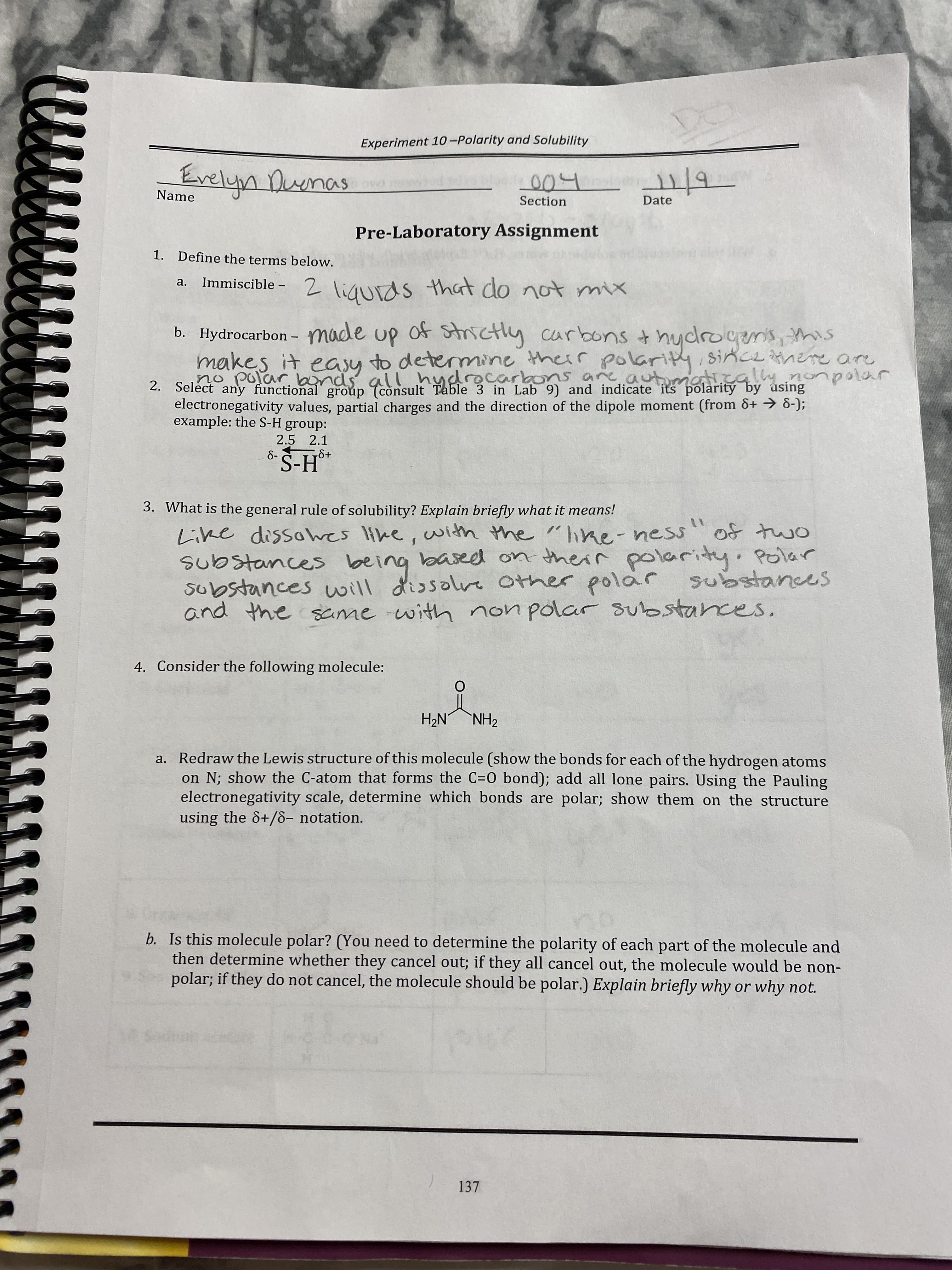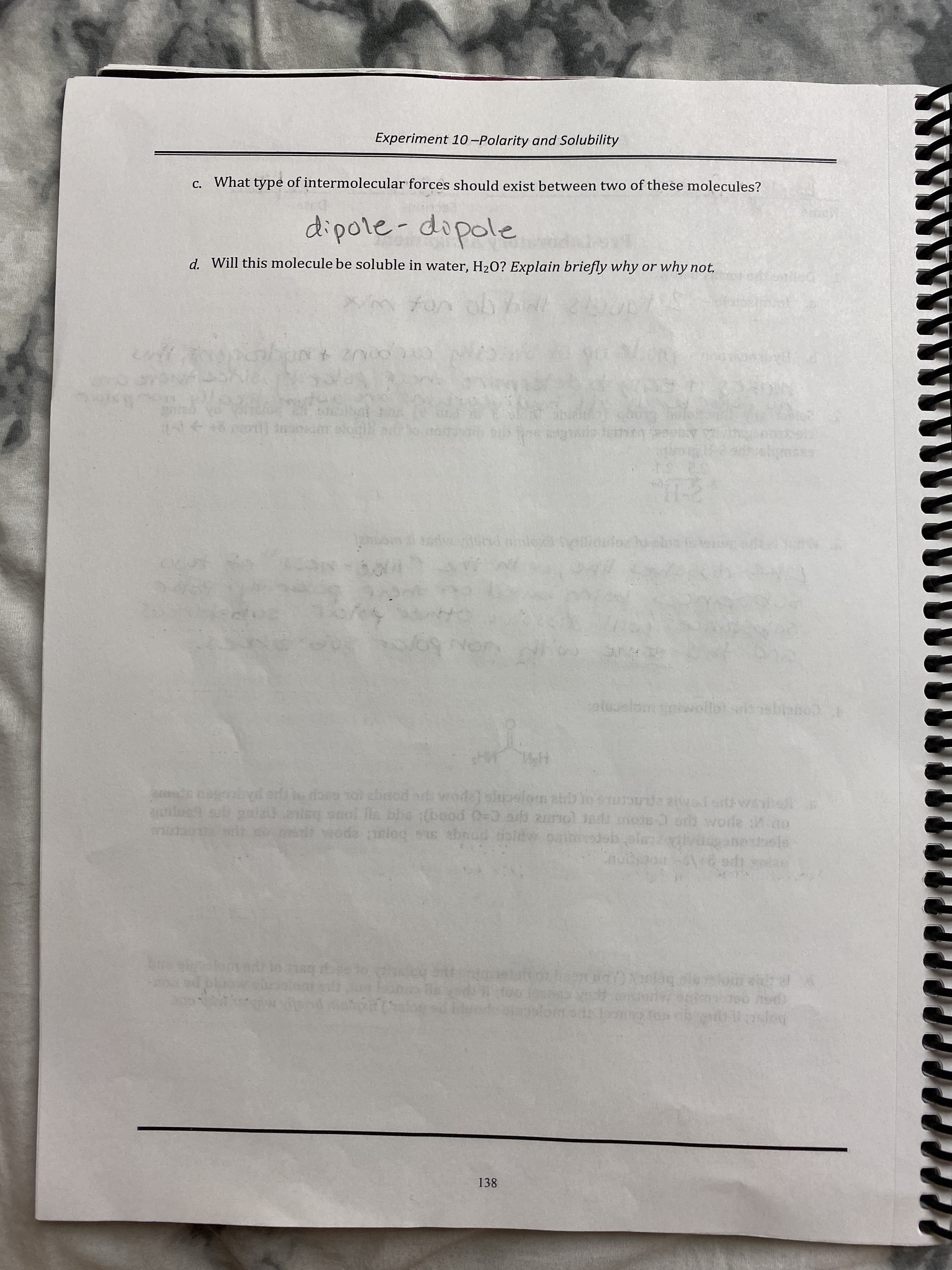Experiment 10-Polarity and Solubility Evelyn Dunas 204 Name Date 2/19 Section Pre-Laboratory Assignment 1. Define the terms below. 2 liqurds that do not mix a. Immiscible – b. Hydrocarbon - made up of Strictly carbons + thydrogenis, this | makes it easy to determine therr polarity, since here are no polar bonds all hydrecark 1s are automati.cally nonpolar 2. Select any functional' group (consult Table 3 in Lab 9) and indicate its polarity by úsing electronegativity values, partial charges and the direction of the dipole moment (from &+ → 8-); example: the S-H group: 2.5 2.1 S+ 3. What is the general rule of solubility? Explain briefly what it means! Like dissowes like, with the "lke-ness substances being substances will dissole Other polar and the same with non polar substances. 11 omt fo based on their polarity Polar substances 4. Consider the following molecule: ZHNNH a. Redraw the Lewis structure of this molecule (show the bonds for each of the hydrogen atoms on N; show the C-atom that forms the C=0 bond); add all lone pairs. Using the Pauling electronegativity scale, determine which bonds are polar; show them on the structure using the &+/8- notation. b. Is this molecule polar? (You need to determine the polarity of each part of the molecule and then determine whether they cancel out; if they all cancel out, the molecule would be non- polar; if they do not cancel, the molecule should be polar.) Explain briefly why or why not. 137 Experiment 10-Polarity and Solubility c. What type of intermolecular forces should exist between two of these molecules? dipole-dipole d. Will this molecule be soluble in water, H2O? Explain briefly why or why not. ton ob h does tol ebrod a wode) sipelom abbio o urud aiyfertwsybelt ood 0-3 ar 201ol Jedi ince oda worde M no mer wode nlog eus abnod alew oain bepx 138
Experiment 10-Polarity and Solubility Evelyn Dunas 204 Name Date 2/19 Section Pre-Laboratory Assignment 1. Define the terms below. 2 liqurds that do not mix a. Immiscible – b. Hydrocarbon - made up of Strictly carbons + thydrogenis, this | makes it easy to determine therr polarity, since here are no polar bonds all hydrecark 1s are automati.cally nonpolar 2. Select any functional' group (consult Table 3 in Lab 9) and indicate its polarity by úsing electronegativity values, partial charges and the direction of the dipole moment (from &+ → 8-); example: the S-H group: 2.5 2.1 S+ 3. What is the general rule of solubility? Explain briefly what it means! Like dissowes like, with the "lke-ness substances being substances will dissole Other polar and the same with non polar substances. 11 omt fo based on their polarity Polar substances 4. Consider the following molecule: ZHNNH a. Redraw the Lewis structure of this molecule (show the bonds for each of the hydrogen atoms on N; show the C-atom that forms the C=0 bond); add all lone pairs. Using the Pauling electronegativity scale, determine which bonds are polar; show them on the structure using the &+/8- notation. b. Is this molecule polar? (You need to determine the polarity of each part of the molecule and then determine whether they cancel out; if they all cancel out, the molecule would be non- polar; if they do not cancel, the molecule should be polar.) Explain briefly why or why not. 137 Experiment 10-Polarity and Solubility c. What type of intermolecular forces should exist between two of these molecules? dipole-dipole d. Will this molecule be soluble in water, H2O? Explain briefly why or why not. ton ob h does tol ebrod a wode) sipelom abbio o urud aiyfertwsybelt ood 0-3 ar 201ol Jedi ince oda worde M no mer wode nlog eus abnod alew oain bepx 138
Chemistry by OpenStax (2015-05-04)
1st Edition
ISBN:9781938168390
Author:Klaus Theopold, Richard H Langley, Paul Flowers, William R. Robinson, Mark Blaser
Publisher:Klaus Theopold, Richard H Langley, Paul Flowers, William R. Robinson, Mark Blaser
Chapter11: Solutions And Colloids
Section: Chapter Questions
Problem 27E: What is the microscopic explanation for the macroscopic behaviour illustrated in Figure 11.15?
Related questions
Question
100%

Transcribed Image Text:Experiment 10-Polarity and Solubility
Evelyn Dunas
204
Name
Date
2/19
Section
Pre-Laboratory Assignment
1. Define the terms below.
2 liqurds that do not mix
a.
Immiscible –
b. Hydrocarbon - made up of Strictly carbons +
thydrogenis, this
|
makes it easy to determine therr polarity, since here are
no polar bonds all hydrecark
1s are automati.cally nonpolar
2. Select any functional' group (consult Table 3 in Lab 9) and indicate its polarity by úsing
electronegativity values, partial charges and the direction of the dipole moment (from &+ → 8-);
example: the S-H group:
2.5 2.1
S+
3. What is the general rule of solubility? Explain briefly what it means!
Like dissowes like, with the "lke-ness
substances being
substances will dissole Other polar
and the same with non polar substances.
11
omt fo
based on their polarity
Polar
substances
4. Consider the following molecule:
ZHNNH
a. Redraw the Lewis structure of this molecule (show the bonds for each of the hydrogen atoms
on N; show the C-atom that forms the C=0 bond); add all lone pairs. Using the Pauling
electronegativity scale, determine which bonds are polar; show them on the structure
using the &+/8- notation.
b. Is this molecule polar? (You need to determine the polarity of each part of the molecule and
then determine whether they cancel out; if they all cancel out, the molecule would be non-
polar; if they do not cancel, the molecule should be polar.) Explain briefly why or why not.
137

Transcribed Image Text:Experiment 10-Polarity and Solubility
c. What type of intermolecular forces should exist between two of these molecules?
dipole-dipole
d. Will this molecule be soluble in water, H2O? Explain briefly why or why not.
ton ob h
does tol ebrod a wode) sipelom abbio
o urud aiyfertwsybelt
ood 0-3 ar 201ol Jedi ince oda worde M no
mer wode nlog eus abnod alew oain
bepx
138
Expert Solution
This question has been solved!
Explore an expertly crafted, step-by-step solution for a thorough understanding of key concepts.
This is a popular solution!
Trending now
This is a popular solution!
Step by step
Solved in 2 steps with 2 images

Knowledge Booster
Learn more about
Need a deep-dive on the concept behind this application? Look no further. Learn more about this topic, chemistry and related others by exploring similar questions and additional content below.Recommended textbooks for you

Chemistry by OpenStax (2015-05-04)
Chemistry
ISBN:
9781938168390
Author:
Klaus Theopold, Richard H Langley, Paul Flowers, William R. Robinson, Mark Blaser
Publisher:
OpenStax

Chemistry by OpenStax (2015-05-04)
Chemistry
ISBN:
9781938168390
Author:
Klaus Theopold, Richard H Langley, Paul Flowers, William R. Robinson, Mark Blaser
Publisher:
OpenStax